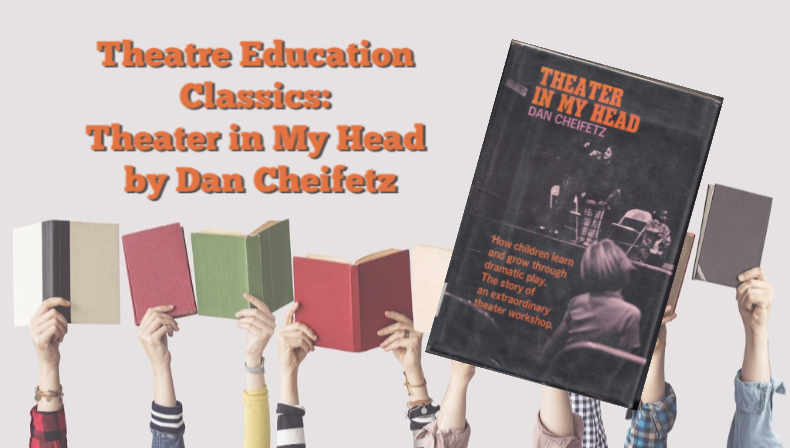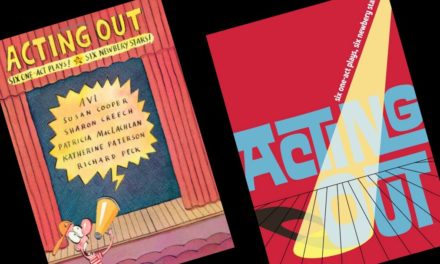“I had never tried this kind of activity before, and had no idea how it would turn out.”
Many theatre education books, especially ones written in the mid-20th Century, tell of successes, but downplay mistakes that could serve as a cautionary example. Theater in My Head is different because Dan Cheifetz is willing to reveal the mistakes he made as a drama teacher. Cheifetz ran a series of theater workshops for New York City-area children in 1969 and 1970, which were integrated both racially and economically. It’s also an unusual text because it’s written as a series of anecdotes featuring different students and Cheifetz’s observations of them. This format allows the reader to experience the classes “in the moment;” rather than imagining how a described activity might work in a class. Cheifetz often presents the directions he gave the class as direct quotes, and details the positive and negative reactions the dramatic activities elicited from participants.
The games Cheifetz implements in his class include many Creative Drama activities; they allow the participants freedom in choosing their topics or the way they will express the idea presented to them. The class plays games, creates pantomimes, and develops improvisations. Cheifetz also adds an element of performance critique; after students share, the class often discusses how the actor could make his intentions and actions more apparent to the audience. The participants think about the way they are communicating in addition to the experience they’re having.
“A child will come up with an original idea – her own kind of idea – when given the freedom to do so.”
One of the most fascinating segments in the book is the activity he called “People Pictures.” It was Cheifetz’s attempt to get each student to value “his own eccentric vision” because “It’s easy to scare or ridicule them out of it.” The participants created works of art using their fellow students as the elements of their picture. Cheifetz doesn’t use the word “tableau,” but this is a common exercise in theatre classes. (My professor Rosalind Flynn has written extensively about tableau technique.) They could use as many classmates as they wanted, and Cheifetz let the “painters” develop their pieces behind a closed curtain. The artists revealed their works to the audience by opening the curtain on the tableaux.
Cheifetz devotes a chapter to describing the performance the class gives at the end of their time together. A sharing session like this is a good way for parents and friends to see what the participants have “been doing” without the pressure of a script or choreography. Cheifetz initially believes that the exploratory and process-oriented nature of the theatre class would be stifled by the presence of a looming “show.” But he’s willing to consider giving “the show for the people” that the students request. The class decides on improvisational situation – a magical imp changes residents of a retirement home into young people – and develops characters for the situation by observing senior citizens in their neighborhoods. Because the performance relied on a predetermined structure and established characters, the students were able to improvise the lines. When a performance is planned like this, there’s little pressure because there are so many “right” ways of communicating the story to the audience, and few “wrong” ones. If an actor is struck by stage fright, unable to say more than one sentence, the other children onstage can pick up the gaps in conversation.
Theatre in My Head is certainly a product of its time. Cheifetz lets the kids express themselves in ways that a teacher today may feel pressured to censor. It was delightful to read about students taking on the roles of “hippie” and “Vietnam War veteran;” I found myself imagining what that interpretation must have looked like. When a “hippie” climbed on the “bus” “smoking something suspicious,” and was followed by a lurching “drunk lady,” I was amazed that Cheifetz didn’t intercede. But he let the class share their authentic experiences of the diverse metropolitan area they were a part of; later in the improvisation, the hippie “offered the bus driver a drag.” Because the language is that of the late 1960s, there are several terms that are outdated. Cheifetz uses “ghetto” to describe the neighborhoods of some of his students, he asks the class to consider how a “lame” person walks. However, none of these incidents or phrases should prevent a 21st-Century theatre teacher from the benefit of reading Theater in My Head.
Theater in My Head is currently out-of-print, but many public and university libraries own a copy; it’s worth searching for one.
Details
TITLE: Theater in My Head
AUTHOR: Dan Cheifetz
PUBLISHER: Little, Brown, and Company
COPYRIGHT: 1971
LIBRARY OF CONGRESS CC#: 79-156866
DEWEY DECIMAL CALL NUMBER: 792.071 C516





